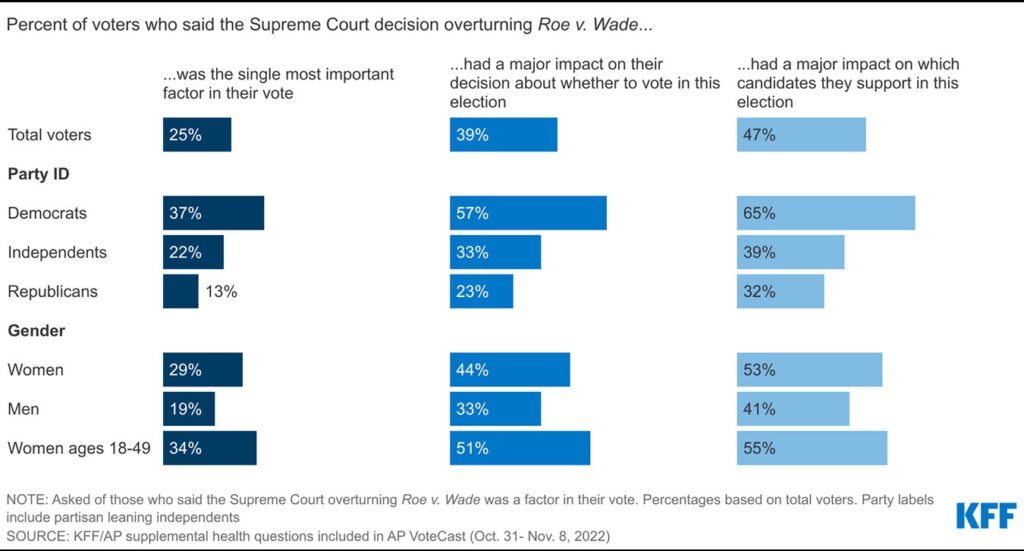
The Unseen Fallout of Abortion Bans
How Threatened Reproductive Rights Pushed More Pennsylvanians Toward Sterilization
News | Video
The 2022 mid-term elections ended up pivoting to a large degree on the health care issue of reproductive rights in a way that was as unique as it was ironic, according to panelists in a Penn LDI virtual seminar of health care political experts that convened three days after the vote.
For one thing, the party of a sitting President didn’t do poorly in the midterms as has traditionally been the case. For another, the years of Republican Party (GOP) efforts to pack the Supreme Court with the conservatives who overturned Roe v. Wade turned out to be the launchpad for a powerful new surge of Democratic voter activism that torpedoed anti-abortion midterm candidates and GOP agendas across the country.

In a sweep of state referendums, voters were consistently pro-choice. In California, Michigan, and Vermont they approved amendments to their state constitutions affirming the right to abortion. In Kentucky, they defeated an anti-abortion amendment to the state constitution. In Montana they rejected the “born alive” bill that was part of an anti-abortion initiative.
“One big takeaway going forward is that the politics of abortion in elections was flipped on its head from the last 50 years,” said panelist Mollyann Brodie, Executive Vice President, Chief Operating Officer, and Executive Director of Public Opinion and Survey Research at the Kaiser Family Foundation (KFF). “In the past, Republicans used this issue to rally their base. This time around, it was the Democrats. The evidence comes from both the (Edison Research) Network Exit Poll and the KFF/Associated Press (AP) VoteCast mid-term voter survey.”
“Four in ten voters said that the Supreme Court decision did have a major impact on their decision about turning out to vote,” continued Brodie. “Almost half said it had a major impact on which candidate they supported. We saw the same patterns in all the states with abortion on the ballot.”

“Another way that abortion mattered at the margin was crossover votes,” said Brodie. “Nationally, about 13% of Republicans and Republican-leaning independents told us that the Supreme Court decision was the most important factor in their vote. But relatively few of those — just 9% — ended up actually casting ballots for the Democratic candidate. But in certain states with the competitive races like Pennsylvania and Arizona, one in five of those Roe-focused Republican voters did end up voting for the Democratic Senate candidate. This is a small share of total voters, but these kinds of crossover votes may matter in these super-close elections.”

Brodie was one of four experts on health care policy and politics who took part in the virtual seminar. The other three were LDI Senior Fellows Allison Hoffman, JD, Professor of Law at the University of Pennsylvania Carey Law School; Daniel Hopkins, PhD, Professor of both Political Science at Penn’s School of Arts and Sciences and the Annenberg School for Communication; and event moderator David Grande, MD, MPA, Associate Professor of Medicine at Penn’s Perelman School of Medicine and Director of Policy at LDI.
Another question in the national KFF/AP VoteCast survey looked more broadly across health care issues in general and found that voters who indicated they were most worried about the costs of health care were more than twice as likely to vote for Democratic candidates. This suggests that even in a closely divided Congress, the Democrats stand to gain from a continued focus on health care policies.
Interestingly, as attention shifted sharply toward reproductive rights as the top health care topic on the midterm campaign trail, the Affordable Care Act (ACA) — the contentious issue that dominated election campaign rhetoric for the last decade — went to ground. It was a non-issue.

“The Republicans ran on repealing the ACA in 2010, 2012, 2014, and 2016, and when they unexpectedly wound up with control of the presidency, the House and the Senate after the 2016 election they moved quickly to repeal the law,” said Hopkins. “They found that the ACA was then unfavorable with more people than [those who] viewed it favorably. But opinion shifted pretty quickly among broad populations of Americans once the alternative was simply repealing the ACA without replacing it with a credible new plan.”
That failed repeal effort was said to be what cost the Republicans control of the House of Representatives in 2018.
Lawsuits also played a big role in the GOP’s decade-long efforts to scuttle the ACA and the federal judiciary remains a critical player in political battles (both today and in the future) over health policy and implementation. In fact, there is still a slow-moving but major lawsuit against the ACA underway in Texas.
Looking beyond the midterm elections to the future, Hoffman pointed out the little-known fact that President Biden has been extremely successful in nominating and winning Senate confirmations for federal court appointees, with 84 judges confirmed during his presidency so far.
“Biden has had three quarters of his nominees be either minorities or women, and that has outpaced any other President,” said Hoffman. “He is reshaping the judiciary in a really remarkable way that hasn’t been talked about.”

“We’re going to have a Supreme Court that’s skeptical of large steps in terms of health policies,” explained Hoffman. “As you think about populating these lower courts, the district courts, and the appeals courts, it shapes the way decisions come up through the courts and it also shapes the future members of the appeals courts and the Supreme Court (because presidents most frequently reach into the federal judiciary for Supreme Court nominees).”
“It matters,” Hoffman continued, “because when federal judges decide things in lower courts, it shapes how the appeals courts and then the Supreme Courts think about those same matters. So, think about these cases that have been coming through with judges like Reed O’Connor of the U.S. District Court Northern District of Texas who says bombastic things like ‘if the individual mandate is unconstitutional, the entire Affordable Care Act should fall.’ Then, that is the decision that the appeals court is thinking about. And then, when these cases get to the Supreme Court, they’re dealing with what these judges have said below them.”
As the session ended, moderator Grande asked the three panelists what they saw as the bright spots and reasons for optimism in the voting patterns? Their answers:
Hopkins: “Some of those candidates who spent less time thinking about what they would do with policy in favor of revving people up in ways that deepened our divisions, lost. I think I will always celebrate more now than I would have in the past any election that comes off without significant violence. Another threat to our democracy that’s slower rolling is redistricting but I think, in at least some places, we saw newly competitive districts that can help our democracy continue to stabilize.”
Hoffman: “I was pleased watching states evolving and how a lot of things played out. We saw the first two openly lesbian governors elected in Oregon and Massachusetts. Some states that used to be swing states, like Florida, have become less so. The composition and how voters think about issues is changing in some states. It’s all creating an interesting puzzle for those of us who think about these questions going forward.”
Brodie: “At a time when we’ve been hearing so much talk about threats to democracy, I look to the enthusiasm of this turnout that was clearly high. We didn’t see a lot of political violence and we’re not seeing what we saw after 2020. For me, it has brought a sense of calm going forward that our democracy is still standing strong. That bodes well for everything in our country, including health policy.”


How Threatened Reproductive Rights Pushed More Pennsylvanians Toward Sterilization

Billing Codes That Flag Food, Job, or Housing Insecurity in Medical Records are Underused for the Sickest Medicare Patients

Promising New Evidence and What’s Next

Abortion Restrictions Can Backfire, Pushing Families to End Pregnancies

With Drastic Cuts on the Table, What’s the Best Way To Fund Medical Innovation – NIH Grants, Prizes, or Bold New Models?

An Analysis of Penn Medicine Healthy Heart Program Provides Insights